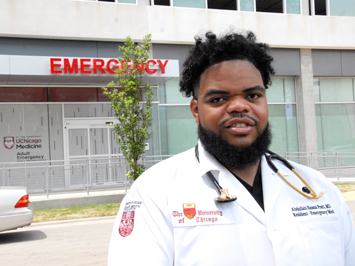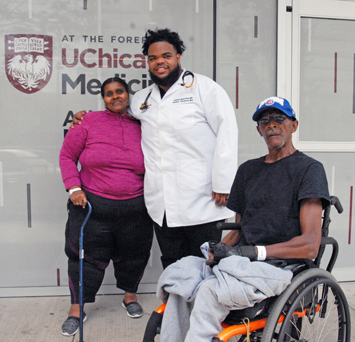For young physician, healing and helping is a personal mission
By by Bryan Crawford -Contributing Writer- | Last updated: Jul 25, 2018 - 10:10:33 AMWhat's your opinion on this article?

Dr. Abdullah Hasan-Pratt
|
But one question that has always puzzled those who have covered Chicago crime and told the stories of the victims and the pain felt by families is this one: Why didn’t the South Side of Chicago have a Level 1 trauma center when so many shootings occur in that area?
“That’s the same question I asked myself when I was a medical student in 2013 and 2014,” Dr. Abdullah Hasan-Pratt, 29, an emergency medical resident at the University of Chicago Medical Center, whose brother tragically fell victim to gun violence in the summer of 2012, told The Final Call.
The last Level 1 trauma center on the South Side closed in 1991 at Michael Reese Hospital in the Bronzeville neighborhood, which shut its doors for good in 2009. Prior to that, the University of Chicago Medical Center was the only other Level 1 trauma facility in existence on the South Side, but due to funding and the high costs to run a unit of that type—trauma centers are not funded by the government, but privately by the hospital or health system—treating patients who oftentimes have no insurance a decision was made to close it in 1988.
In 2013, Dr. Marie Crandall, surgery and trauma care professor at Northwestern University, analyzed 11,744 gunshot victims in Chicago over a 10-year period between 1999-2009. In the data parsed by Dr. Crandall, it was discovered that 4,782 people who were Black and most likely uninsured, were shot more than five miles from the nearest Level 1 trauma center.
Subsequently, the mortality rate for those people was 8.7 percent, which translates to roughly 6.3 excess gunshot deaths annually. Conversely, if someone is shot within five miles of a Level 1 trauma center, the mortality rate is much lower, 6.4 percent.
After seven years of rallies, protests, political bickering and posturing in the wake of the death of Damian Turner, an 18-year-old youth activist who was shot four blocks from the University of Chicago, but was transported nine miles away to Northwestern Memorial Hospital where he died, the South Side, once again has a Level 1 trauma center at the University of Chicago Medical Center, which opened this year on May 1.

Dr. Hasan-Pratt with a couple of his patients, (left) Patricia McCoy and (right) Michael Bellamy.
|
“It’s exciting that we have this trauma center because funding is always a huge issue,” Dr. Hasan-Pratt explained. “For this facility to be opened, it shows that there was a more altruistic motive. The hospital basically said we’re going to create this trauma center because it needs to be created. We’re creating it because there’s an outcry for it, or because it’s a training facility. All of these tertiary motives outweigh the financial motives which are more commonly seen in the way many hospitals run. Many African American doctors, who dedicated their life to the South Side of Chicago, had low hope that this kind of facility would be opened on this side again.”
Dr. Hasan-Pratt also lauds the community organizations for their passionate protests to speak up for what was needed most to help the most vulnerable people in many of the city’s toughest neighborhoods. “They deserve a large round of applause that they may not be getting right now,” he said. “They used their passion and desires to see better for their community, to initiate change. That’s the number one reason this facility is open. Their voices outweighed the burden of treating uninsured patients and opening the doors up right in the heart of where we’re seeing many of the gunshot victims, because that’s what the South Side is known for.”
As an emergency room physician, Dr. Hasan-Pratt sees many patients with various ailments, not just gunshots. Because these patients are Black, he feels one of his biggest advantages working in this new, state of the art facility, is in being able to gain the trust of people who look like him, making them much more likely and comfortable to open up and be honest about what is happening with them healthwise.
Having a general distrust of doctors, particularly White doctors, has long been an unspoken part of Black culture. However, Dr. Hasan-Pratt has found that he has easily been able to overcome this just by being himself and letting his patients know that he understands because he comes from where they come from, making it easier for him to communicate with and educate his patients.
“I have patients on a daily basis, pretty much tell me straight up to my face when I first walk in the room—once they get past my age and tell me how young I look to be a physician—that they’re proud of me, or that they didn’t expect to come to UCMC and be treated by an African American doctor,” he said.
“That makes me happy to hear them say that I speak their language, or that I sound like their nephew or son. So not only is it a comfort thing, but research has shown that when a patient has a high level of trust for their physicians, it’s key in their overall health outcomes. Meaning, they’re much more willing to adhere to the prescribed medical treatment regimen, or they’re much more willing to be forthcoming with health information. Some patients won’t tell their doctors certain things because they worry that information might be used against them.”
While Dr. Hasan-Pratt is on the frontlines of treatment that is much needed in the Black community, not just in Chicago, but across the country, he underscores the need for more people like him—more Black men and women from low-income or impoverished communities, to become physicians, or work in other medical and health care related fields, to give back to their community in that way because the need is so great and the work, so rewarding.
“When I was younger and wanting to become a doctor, all I kept thinking about was how I wanted to advocate and help the community,” he explained. “I think that’s something that needs to be addressed and it’s something I hope to help change in whatever small way that I can. Even if that means just going to a school and letting them know that you can be young, you can be Black, you can be from the South Side, or Baltimore, or St. Louis or L.A. and still become a physician and not lose yourself and who you are in the pursuit of it,” Dr. Hasan-Pratt explained.
“Too many of our Black physicians over the past few generations, have left their communities because getting out the ’hood has become our mindset. But what that does is lower the number of Black physicians and doctors that our children can see everyday, identify with and aspire to become. That does a lot of damage to our communities and we need more people who want to stay around and commit to being that example for the younger generations.”
INSIDE STORIES AND REVIEWS
-
-
About Harriett ... and the Negro Hollywood Road Show
By Rabiah Muhammad, Guest Columnist » Full Story -
Skepticism greets Jay-Z, NFL talk of inspiring change
By Bryan 18X Crawford and Richard B. Muhammad The Final Call Newspaper @TheFinalCall » Full Story -
The painful problem of Black girls and suicide
By Charlene Muhammad -National Correspondent- » Full Story -
Exploitation of Innocence - Report: Perceptions, policies hurting Black girls
By Charlene Muhammad -National Correspondent- » Full Story -
Big Ballin: Big ideas fuel a father’s Big Baller Brand and brash business sense
By Bryan Crawford -Contributing Writer- » Full Story






 Click Here Stay Connected!
Click Here Stay Connected!








